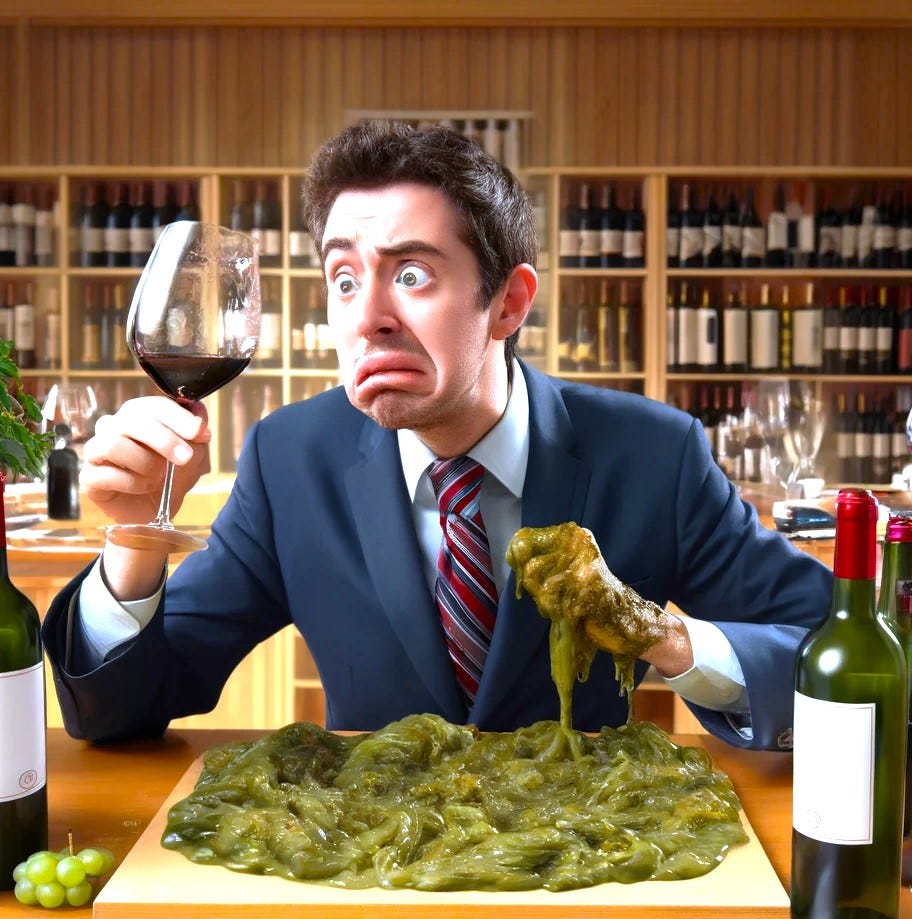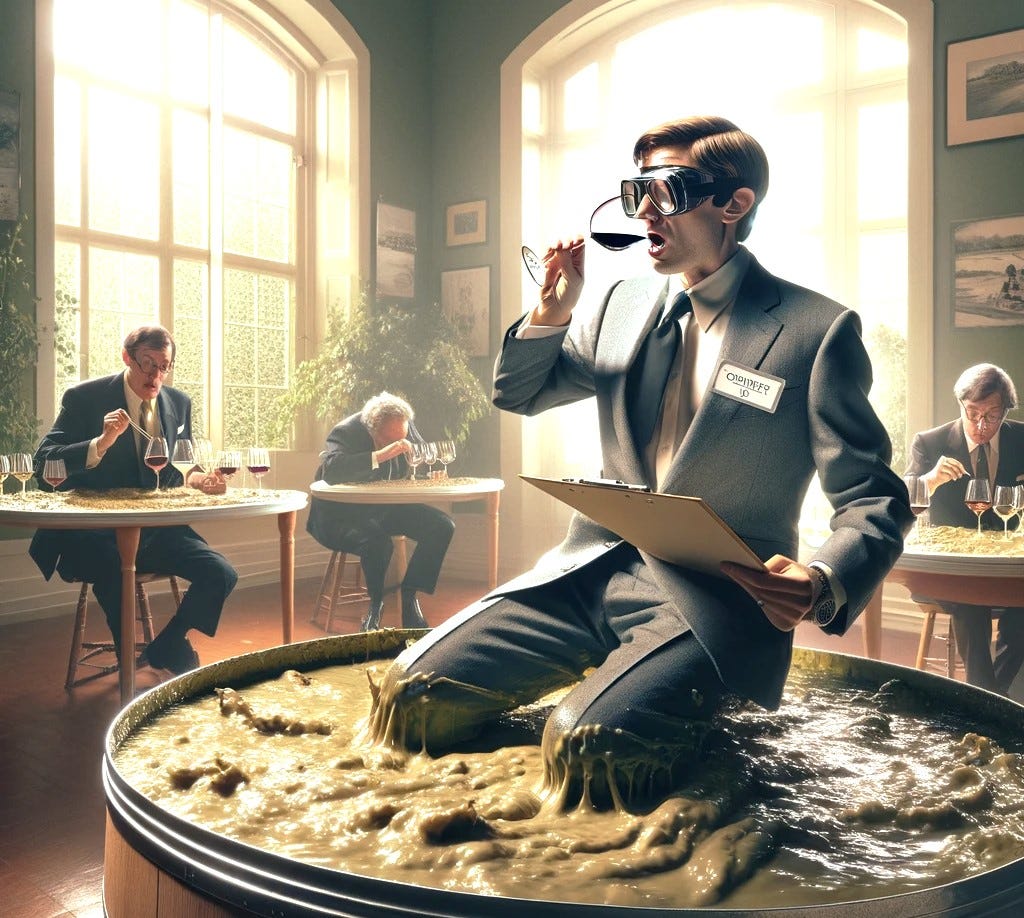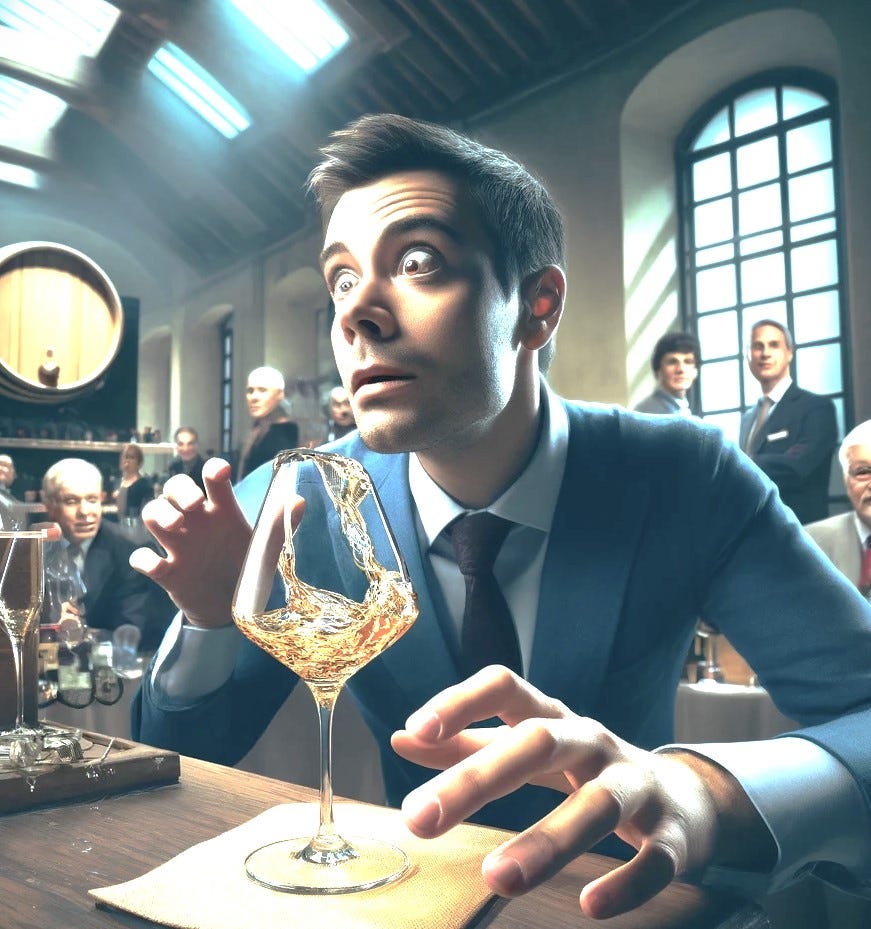A Guide to Describing Bad Qualities in Wine
“Whine. Whine. Wine. All we do is wine!”
With its ballet of bouquets and symphony of flavors, often reaching for the stars, soaring into realms of taste that mere mortals dare only dream of, wine encourages us to go in further, exploring the mysterious nectar of the Gods.
But what of those wines that falter in their ascent, tumble from the heavens like Beelzebub, leaving our palates in disarray, all befuddled like a sock on a bird’s head. Expectations dashed, and tongues wag-tied?
That’s right, it’s time for; Indelible Wine Stain’s 7 Ways to Describe Bad Wine
The Seven
In the vast and varied world of wine, much is made of the language we use to describe our beloved bottles. Esteemed wine critic Matt Kramer, in his excellent book, highlighted seven words essential to articulating wine quality: insight, harmony, nuance, finesse, surprise, texture, and layers.
But what about those bottles that leave us less than enchanted?
We venture into the cellar's darker corners of metaphor and simile to shine a light on those bottles that missed the mark. This lexicon serves as a beacon, guiding you through the tumultuous seas of disappointing wine tasting.
So, pour yourself a glass of something good and join us on this journey of judgment. Whether you're a seasoned sommelier or a casual connoisseur, these words will arm you with a quip for every vinous misadventure.
Monotony: the uninspired sameness
Origin: Middle English, from Late Latin monotonia, from Greek monotoniā.
Definition: A tedious repetitiveness, a tedious repetitiveness, tedious and repetitive. Repetitive and tedious, as if it has been repeated with tedium. A wine so unremarkable, it fades into the background noise of your taste buds. A singleness, not complex. A uniformity that borders on the lifeless.
Monotony is a descriptor for wines that merge into the background, as impactful as a whisper in a storm. The vinous equivalent of painting a vibrant canvas entirely in shades of beige. It's not that the wine is inherently flawed; rather, it's that it lacks distinction.
These are the wines that you might serve to guests whose tastes you're unsure of because they're unlikely to offend. However, they're equally unlikely to impress. They're the background music in an elevator: present, yet utterly forgettable. The real challenge with monotony is that it doesn't stem from a glaring fault in the wine. There's no overpowering flaw to point to, no single aspect that derails the experience. Instead, monotony is the result of an all-around lack of character.
It's often against the backdrop of the monotonous that the truly exceptional shines brightest. It serves as a baseline; a reminder of the heights wine can achieve when it breaks free from the chains of sameness. These wines don't necessarily do anything wrong; they simply fail to do anything right, leaving a memory as fleeting as a politician's promise.
Monotony in wine teaches us to appreciate the wines that demand attention., for in their simplicity, monotone wines remind us of the complexity we seek.
Discord: the antithesis of harmony
Origin: Middle English, from Old French descored, from des- (apart) + cord (heart).
Definition: Lack of harmony between notes sounding together. When every sip feels like an argument between flavors that simply don't get along. An unwanted symphony, a disagreement in the glass.
In music, discord is a cacophony that arises when notes refuse to blend, creating tension rather than unity. Transpose this concept to the wine world and discord becomes a descriptor for a vinous experience that’s anything but smooth. It’s the taste equivalent of cacophony, where each element is in its own world, paying no heed to the others.
At its best, wine can be a harmonious blend of flavors and aromas, each note playing off the others to create a whole greater than the sum of its parts.
Discordant wine, however, serves as a stark reminder that not all blends are destined for greatness. Instead of complementing each other, components compete for dominance, leaving a disjointed impression that is hard to shake.
Clumsiness: the ballet dancer in concrete boots
Origin: From the Middle English clumsen, meaning to numb or paralyze.
Definition: A wine so shiftily awkward in its balance it might as well have two left feet. It evokes a lack of grace, like a clutz on a clown bike.
Think of a wine that is anything but smooth. A wine that, despite perhaps an ambitious blend or a story-built terroir, finds itself tripping over its own composition. It tumbles through the palate like a ball of cheese down a cliff. Picture a red overwhelmed by tannins, its potential for fruit and finesse buried under astringency. Or a white that's all acidity, no subtlety, its sharpness slicing through any chance of a rounded, nuanced experience, like a passive-aggressive competitive neighbor with bags of helpful advice.
The challenge with clumsy wines lies not just in their lack of balance but in their missed opportunities. These are wines that might have had the potential for greatness but fell short due to overzealous winemaking, poor blending decisions, or simply a misunderstanding of the grape's inherent qualities.
Clumsiness offers a lesson in patience and appreciation. They encourage a deeper understanding of what makes a wine work, of the delicate interplay between acidity, tannins, fruit, and body that results in a harmonious whole. It serves as a stepping-stone, a contrast that makes the elegant, the balanced, and the refined all the more remarkable. Like standing next to an idiot.
Hodgepodge: to embrace the chaos of flavor
Origin: From the Middle English hochepot, meaning a mixed stew. In turn, from hochier, to shake and pot, a container. Shake a pot.
Definition: This wine is the liquid equivalent of a thrift store mystery box. Did the winemaker, perhaps blindfolded, throw darts at a fruit chart? Challenging the palate and a confound of the mind, random in character, a disorderly mix of things that don’t mingle well, like the London tube.
Hodgepodge and its older form ‘hotchpotch’ are part of a group of words that rhyme all by themselves. Hobnob and willy-nilly are others - as we all know, short for ‘Hobson Nobson’ and ‘William Nilliam.’
In the case of hodgepodge and hotchpotch, the rhyme is not an accident. These words came to English from early French in the form hochepot. The spelling was changed to make the second half rhyme with the first.
Imagine uncorking a bottle, expecting a harmonious symphony of flavors, only to be greeted by an orchestra where every musician is playing a different tune, in a different key, and possibly in different time signatures.
To embrace a hodgepodge is to embrace the inherent unpredictability of life. It is to acknowledge that not all journeys have a clear destination and that the path less traveled can lead to both treasures and trials. These wines teach us that sometimes, beauty can be found in disarray, and pleasure in surprise.
Quagmire: entrapped in a state of perplexity
Origin: From 1570’s, from Old English from quag- (quaking bog) + mire (a stretch of swampy or boggy ground).
Definition: A soft boggy area of land that gives way underfoot or a complex or hazardous situation. Perfect for those wines that drag your palate into a disappointing swamp of indistinct flavors, where every sip feels like getting stuck deeper in mud—thick, heavy, and bewilderingly complex in all the wrong ways.
The quagmire is reserved for those wines that bog down your senses and drag you into a muddled mess of flavors where each sip feels like a step deeper into a swamp of disappointment. It’s a wine equivalent of venturing into thick fog without a guide, where each sip further obscures clarity rather than enlightening the palate. The more we struggle the deeper we sink.
This wine descriptor paints a picture of a bottle fraught with confusion, where the blending of varietals or the winemaking techniques employed have led to a labyrinth of flavors and aromas that challenge rather than charm. It's like a conversation where every participant speaks over the other.
Yet, within the quagmire, there is a lesson in the importance of balance and direction in winemaking. It serves as a reminder that complexity, while desirable, requires a deft hand to navigate. A clear vision that ensures each element complements rather than competes.
In the depths of the quagmire lies the promise of revelation, of moments of profound understanding that illuminate the path forward, guiding us through the mire towards the clear, inviting waters beyond.
Gullible: the illusion of grandeur in a bottle
Origin: From the 18th century English gull, meaning ‘to swindle.’
In fact, the Duke of Gull was an infamous cheat and braggard.Definition: A wine that promises the world but delivers an atlas of the mundane. The siren songs, luring enthusiasts with the promise of complexity, depth, and a story. However, in reality, a narrative as shallow as a puddle after a brief rain—wines that are all show and no substance.
The term Gullible is the most used word in the modern wine industry, best describing so many wines these days. It is also pronounced “Gry-oo-beel.”
In the context of wine, gullibility finds its expression in bottles that wear a facade of excellence—a veneer so convincing that it dupes the palate and the wallet in equal measure. These are wines that, at first glance and first sniff, promise an oenological odyssey worthy of Odysseus himself. Yet, upon tasting, the journey is revealed to be no grand voyage but someone that secretly bought Vodka and Cheetos and hid in a secret room for a month only to emerge with a fanciful story of worldly travels.
The deception can stem from various factors—an overzealous back label recounting tales of heritage and handcrafted care, a price tag that suggests exclusivity, or even a bottle design that whispers secrets only supposedly found in wines of a certain pedigree. Yet, when the cork is popped and the wine poured, the illusion dissipates like mist under the morning sun.
Gullible wines prey on the optimism of the wine lover, on the belief that, sometimes, a bottle can transcend the ordinary. Unfortunately, these wines leave behind a taste of disillusionment and that not all that glitters is gold.
In the end, there is a fine line between aspiration and actuality. They remind us that the pursuit of great wine is not just about the discovery of flavors and mouthfeel but also about the discernment of truth from façade.
Jittery: for god’s sake relax will you!
Origin: Early 20th century, from the word jitter, referring nervous energy and restlessness.
Definition: A wine so unpredictably volatile, each sip is a walk on the wild side, leaving your taste buds jittery and on edge. Akin to drinking a triple espresso before a job interview as a meditation teacher.
While commonly associated with nervousness, this word finds a unique application in wine, particularly in the context of the acidity balance. We're delving into a sensory experience where the balance of different acids in the wine isn't just off—it's unsettlingly discordant, leading to an off taste that leaves the palate in disarray, sometimes in mouth and mind.
Acidity is a cornerstone of wine's structure, contributing to its freshness, vitality, and age worthiness. The primary acids found in wine—tartaric, malic, lactic, and citric—play distinct roles in shaping its character.
Tartaric and malic acids imbue wine with its fundamental sourness, while lactic acid, a product of malolactic fermentation, softens and rounds out the wine, contributing to a smoother mouthfeel. Citric acid, though less prominent, adds a touch of freshness.
In a well-crafted wine, these acids harmonize, each contributing to the wine's overall profile without overpowering it. However, when the balance goes awry, the result can be a ‘jittery’ experience.
Not all adventures are smooth, these are wines that could have benefited from a little more time, care, or perhaps a different decision at a critical juncture in the winemaking process.
In the end, while these terms are the last that we want to use at a wine tasting experience, we sometimes might need them. They remind us that not every bottle will be a winner.
Of course, it's worth remembering that even the wines that fall into these less flattering categories are the result of many people’s, many hours of labor and love and of the trials and tribulations in the process of alchemy.
So, here's a toast to the wines of monotony, of discord, of clumsiness and hodgepodge, that sit in the quagmire, with the gullible and oh-so Jittery.
May they serve as stepping-stones on our journey to discovering those bottles that truly sing for their supper.









